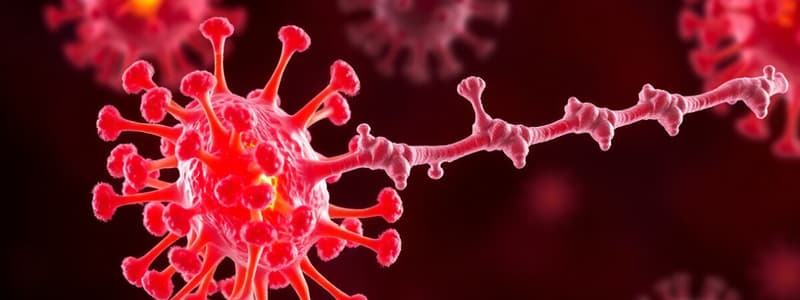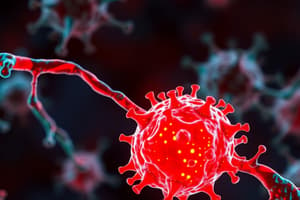Podcast
Questions and Answers
What is the role of chemokine signaling in the immune system?
What is the role of chemokine signaling in the immune system?
- Enhancing apoptosis in all cells
- Inducing B-cell differentiation exclusively
- Directing leukocyte migration (correct)
- Inhibiting leukocyte migration
What structure do chemokine receptors belong to?
What structure do chemokine receptors belong to?
- Monomeric proteins
- Dimeric receptors
- Single-pass transmembrane proteins
- G-protein-coupled receptors (correct)
What is a characteristic feature of chemokines?
What is a characteristic feature of chemokines?
- They are always produced by lymphoid cells
- They generally exist as heterodimers
- They have highly conserved disulfide bonds (correct)
- They possess variable cysteine residues
Which statement is true regarding the interaction of chemokines and their receptors?
Which statement is true regarding the interaction of chemokines and their receptors?
What determines a cell's susceptibility to a ligand in a signaling pathway?
What determines a cell's susceptibility to a ligand in a signaling pathway?
What type of bonds are important for the structural integrity of chemokines?
What type of bonds are important for the structural integrity of chemokines?
What role do tyrosine phosphorylation and ITAMs play in T and B cells?
What role do tyrosine phosphorylation and ITAMs play in T and B cells?
What is the primary role of chemokines in the immune response?
What is the primary role of chemokines in the immune response?
Which of the following co-receptors is essential for T-cell activation?
Which of the following co-receptors is essential for T-cell activation?
Which of the following statements about IL-17 family cytokines is correct?
Which of the following statements about IL-17 family cytokines is correct?
Which receptor is primarily associated with B-cells?
Which receptor is primarily associated with B-cells?
What types of antigens do B-cell receptors typically bind to?
What types of antigens do B-cell receptors typically bind to?
Which transcription factors are involved in T-cell activation?
Which transcription factors are involved in T-cell activation?
Which of the following statements about dendritic cells is true?
Which of the following statements about dendritic cells is true?
What does the immuno-receptor tyrosine activation motif (ITAM) do?
What does the immuno-receptor tyrosine activation motif (ITAM) do?
Which MHC class interacts with CD4 co-receptors?
Which MHC class interacts with CD4 co-receptors?
What role do adaptor proteins play in signaling pathways?
What role do adaptor proteins play in signaling pathways?
What happens to NFAT after it is activated by Calmodulin?
What happens to NFAT after it is activated by Calmodulin?
Which factor is necessary for the activation of Ras?
Which factor is necessary for the activation of Ras?
What is the function of GTPase activating proteins (GAPs) in relation to Ras?
What is the function of GTPase activating proteins (GAPs) in relation to Ras?
How does the Ras/MAP kinase cascade affect transcription?
How does the Ras/MAP kinase cascade affect transcription?
What initiates the activation of NF-κB in the cytoplasm?
What initiates the activation of NF-κB in the cytoplasm?
What is the outcome of phospholipase C gamma (PLCγ) activity on calcium ions?
What is the outcome of phospholipase C gamma (PLCγ) activity on calcium ions?
Which cells are involved in enhancing phagolysosome activity during immune responses?
Which cells are involved in enhancing phagolysosome activity during immune responses?
Flashcards
TNF-related factors
TNF-related factors
Proteins (like TNF) that influence cell behavior, especially immune responses.
Lymphocyte Differentiation
Lymphocyte Differentiation
The process of immune cells (lymphocytes) changing into specialized cells with specific functions.
BAFF and APRIL
BAFF and APRIL
Proteins essential for B-cell development and survival.
CD40 Ligand (CD40L)
CD40 Ligand (CD40L)
Signup and view all the flashcards
Fas Ligand (FasL)
Fas Ligand (FasL)
Signup and view all the flashcards
IL-17 family
IL-17 family
Signup and view all the flashcards
Chemokines
Chemokines
Signup and view all the flashcards
Chemokine receptors
Chemokine receptors
Signup and view all the flashcards
Cellular signal
Cellular signal
Signup and view all the flashcards
Ligand-receptor binding
Ligand-receptor binding
Signup and view all the flashcards
Tyrosine phosphorylation of ITAMs
Tyrosine phosphorylation of ITAMs
Signup and view all the flashcards
Chemokine and cytokine production
Chemokine and cytokine production
Signup and view all the flashcards
Macrophage and neutrophil activation
Macrophage and neutrophil activation
Signup and view all the flashcards
Adaptive immune activation
Adaptive immune activation
Signup and view all the flashcards
Antigen presentation enhancement
Antigen presentation enhancement
Signup and view all the flashcards
B and T cell motility
B and T cell motility
Signup and view all the flashcards
B-cell receptor
B-cell receptor
Signup and view all the flashcards
T-cell receptor
T-cell receptor
Signup and view all the flashcards
MHC Class I
MHC Class I
Signup and view all the flashcards
MHC Class II
MHC Class II
Signup and view all the flashcards
Co-receptor
Co-receptor
Signup and view all the flashcards
Cell division and differentiation
Cell division and differentiation
Signup and view all the flashcards
Cytokine production (detail)
Cytokine production (detail)
Signup and view all the flashcards
NFAT and NF-κB
NFAT and NF-κB
Signup and view all the flashcards
AP-1
AP-1
Signup and view all the flashcards
Phosphorylated tyrosines
Phosphorylated tyrosines
Signup and view all the flashcards
Receptor Dimerization
Receptor Dimerization
Signup and view all the flashcards
Lipid Rafts
Lipid Rafts
Signup and view all the flashcards
Adapter Proteins
Adapter Proteins
Signup and view all the flashcards
Phospholipase Cγ (PLCγ)
Phospholipase Cγ (PLCγ)
Signup and view all the flashcards
Calcium signaling
Calcium signaling
Signup and view all the flashcards
Calmodulin (CaM)
Calmodulin (CaM)
Signup and view all the flashcards
NFAT
NFAT
Signup and view all the flashcards
Ras
Ras
Signup and view all the flashcards
Ras Activation
Ras Activation
Signup and view all the flashcards
Ras Inactivation
Ras Inactivation
Signup and view all the flashcards
MAP kinase cascade
MAP kinase cascade
Signup and view all the flashcards
ERK
ERK
Signup and view all the flashcards
AP-1
AP-1
Signup and view all the flashcards
PKC
PKC
Signup and view all the flashcards
NF-κB
NF-κB
Signup and view all the flashcards
Antigen Signaling
Antigen Signaling
Signup and view all the flashcards
Study Notes
Sensations: Receptors and Signaling
- The presentation is about sensations, receptors, and signaling.
- Key concepts include receptor-ligand interactions, cytoplasmic signaling molecules, TNF functions, and transcription factors in T-cell activation.
Supporting Literature
- Kuby Chapters (Chapter 3) are referenced.
- Research on AP-1, NF-κB, NFAT pathways in innate lymphoid cells is discussed.
- CXC44 and HIV interaction is explored.
- Overview of TCR and TLR minireview is covered.
Discussion Questions
- Question 1: What are the cytoplasmic signaling molecules, and what do they do?
- Question 2: What are the principal functions of TNF?
- Question 3: What are the three main transcription factors participating in antigen-dependent T-cell activation, and how do they work?
Session 2
- "Good communication is as stimulating as black coffee, and just as hard to sleep after." – Anne Morrow Lindbergh (quote)
Let's Bond...
- Receptor-ligand interactions involve non-covalent bonds.
- Non-covalency: In immunology, cell-to-cell communication occurs via receptor-ligand interactions (non-covalent)
- Affinity: Normally, the strength of the individual bonds is generally weak.
- Avidity: Multiple bonds resulting in a high cumulative bind strength.
- Valency: Increasing the valency of receptors increases avidity.
Immunoglobulin (BCR)
- Antibodies extend from the hinge region.
- Glycosylation helps spread heavy-chain domains apart, playing a functional role.
- Antibodies have an antigen-binding domain, binding two antigen molecules.
- Contains proline (flexible) and cysteine (heavy-chain dimer formation).
- Membrane-bound antibodies have extracellular, hydrophobic transmembrane, and cytoplasmic tails.
- Alternative splicing mechanisms produce secreted antibodies by removing/replacing these regions.
T-cell Receptor (TCR)
- Similar to BCR, contains immunoglobulin domains.
- TCR has α and β subunits, with constant and variable regions.
- Variable regions possess three CDRs forming peptide-specific binding sites.
- Constant regions contain transmembrane regions.
- Two types (αβ and γδ) with diverse antigen-binding characteristics.
Co-receptors
- Co-receptor binding enhances antigen-immune system receptor interactions.
- Interactions occur near the original receptor-ligand interaction.
- A single interaction may be insufficient for activation.
- Co-receptors can provide a second signaling interaction for complete cell activation.
Immunoglobulin 2-D and Space-Fill Models
- Two heavy chains (variable and constant regions) and two light chains held together by disulfide bonds.
- Models show variable and constant regions, hinge regions, antigen binding sites, and effector function sites.
Structural Differences
- Secreted antibodies are grouped into five major classes (IgA, IgD, IgE, IgG, IgM).
- Each class differs in their heavy chain types (α, δ, ε, γ, μ).
- Light chains are Kappa (κ) or Lambda (λ).
- Different classes have different functions in immune responses.
Innate Immune Receptors
- Recognize PAMPs (Pathogen-Associated Molecular Patterns).
- Receptors for PAMPs, like Toll-like receptors (TLRs), are uniformly distributed on cell types.
- Receptors can be integral membrane proteins or intracellular proteins, recognizing recurring patterns on bacteria, yeast, and parasites.
Human PRRs
- TLR, CLR, RLR, NLR, and ALR are examples of human pattern recognition receptors (PRRs).
- Each PRR has a different cell location and recognizes different PAMPs.
- PRRs play essential roles in immune responses.
Signaling Molecules
- Cytokine signals are generated by ligand binding to cell receptors.
- Cytokine-receptor binding is noncovalent (typically high affinity).
- Cytokine-signaling results in changes in the target cell's transcriptional program, inducing metabolic or proliferative changes.
How Cytokines Work
- Cytokines are proteins that mediate immune responses.
- They act through three different mechanisms (endocrine, paracrine, and autocrine).
Cytokine Action
- Cytokine action can be pleiotropic (different biological effects), redundant (similar effects), synergistic (combined effects greater than additive), antagonistic (opposite effects), and cascade effect. (multiple downstream cytokines).
Practical Examples
- Presentation of many practical examples of cytokine actions on various immune cells.
The Six Cytokine Families
- Summarization of six major cytokine families (IL-1, Class 1/2, TNF, IL-17, Interferons, etc.).
- Each family has representative members with diverse functions and roles in immune responses.
Receptor Meets Ligand
- Ligand binding to a receptor causes conformational changes, dimerization/clustering, membrane location changes, and covalent modifications.
Adaptive Immune Receptors
- Summary of adaptive immune receptors (immunoglobulins – BCR, and TCR).
- Important receptors are highlighted (immunoglobulin domains, variable and constant regions, etc.).
- Additional related components like co-receptors (CD4, CD8), and tyrosine kinases with their specific roles are noted.
Putting It All Together
- Summary of the overall process and key features of immune responses and cell signaling. Summarizes the process.
NFAT and NFκB Detail
- Diagram illustrates the intricate interplay of NFAT and NFκB in response to antigen stimulation.
AP-1 Detail
- Diagram showing AP-1 activation pathway induced by extracellular stimuli leading to changes in gene transcription.
Comparison of B and T Cells
- Compares and contrasts B-cell and T-cell receptors, accessory proteins, ligands, co-receptors, tyrosine kinases, adaptor proteins, and effector molecules involved in their signaling pathways.
Lift Off...
- Summary of immune cell functions in response to infection: leukocytes, macrophages, neutrophils, dendritic cells, B cells, and T cells.
Session 3 Prepare
- Important questions regarding the innate immune system (innate components, role of phagocytes, and properties of neutrophils and macrophages).
Studying That Suits You
Use AI to generate personalized quizzes and flashcards to suit your learning preferences.




